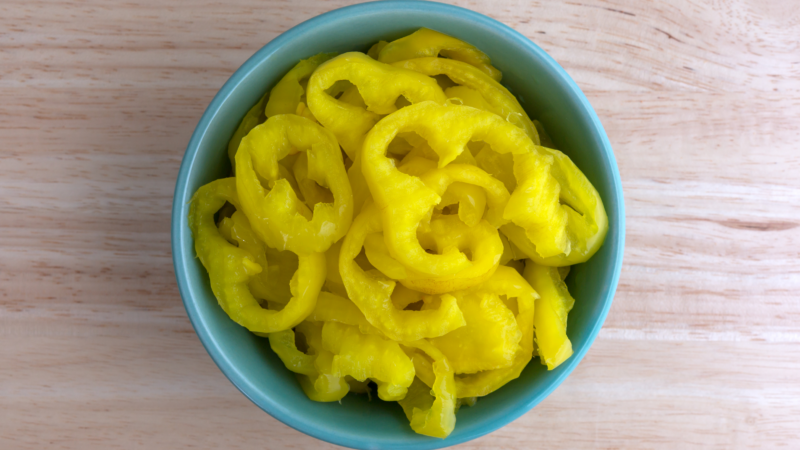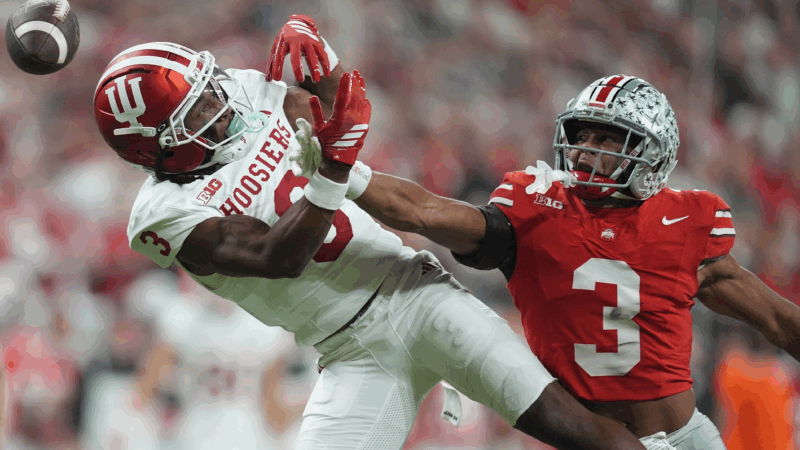A pickled pepper maker knows exactly how hard it is to switch to natural food dyes
The Trump administration’s Make America Healthy Again effort hopes to eliminate potentially harmful synthetic dyes from the food supply.
Manufacturers use those dyes to make foods, drinks and medicines in vivid colors, but the government argues that those cosmetic additives are both harmful and easy to substitute.
Dr. Marty Makary, the new commissioner of the Food and Drug Administration, addressed the issue at a recent event attended by a contingent of “MAHA moms” in addition to media outlets. Makary told food and beverage companies that switching to all-natural food dyes should be easy.
“Try watermelon juice,” Makary suggested, holding up a sequence of small jars of liquid as the audience laughed, “or beet juice.”
Experiments and expense
But how simple is it to switch to all-natural dyes?
Mark Oliveria, owner of Oliveria Peppers based in Clarksburg, W. Va., found out for himself about five years ago, when his grocery-chain buyers pointed to greater consumer demand for more all-natural products. They asked Oliveria if he could remove the Yellow Dye No. 5 he’d used in his bright yellow banana pepper recipe.
So Oliveria ran kitchen experiments, initially using ground turmeric root, the powdered spice that makes curry so easily stain clothes.
“It took me a little while to get the color exact, because within six to eight weeks in the jar, it would start lightening up,” he says. “So the first year, we had a little bit of a tough time, and it was mainly because we were using the powdered form, which didn’t hold its color as long.”
Oliveria then found a liquid version of the turmeric dye that was pricier and required more quantity but worked perfectly and did not fade. And although he says Yellow Dye No. 5 still remains approved to use in food, he’s now happy he’s able to remove it from his ingredients.
That move five years ago put Oliveria ahead of the curve.
Europe has since banned more synthetic dyes, and required manufacturers to include warning labels about the dyes in their food products. Canada imposed limits on the amount of dye that can be used in food, and requires dyes to be listed on labels.
Government actions
In the U.S., the Biden administration banned Red Dye No. 3 in January just before leaving office. Last month, the Trump administration said it wants to go further, getting food, beverage and pharmaceutical industries to voluntarily eliminate all petroleum-based dyes by the end of next year. The FDA also recently approved three new all-natural dyes for manufacturers to use.
For Oliveria, who relied on only a single dye, finding an alternative was relatively easy, but he says that likely won’t be the case for other companies more reliant on petroleum-based dyes like Red No. 40, or Blue No. 1 or Blue No. 5 across more of their products.
“I think in the snack industry, in the drink industry, they’re going to have a tougher time,” he says.
Indeed, Rep. Chuck Fleischmann, R-Tenn., raised the snack industry’s concerns last week during a House Appropriations Committee hearing where Health Secretary Robert F. Kennedy Jr. testified. Fleischmann said he represents many snack companies that have factories in his district in eastern Tennessee.
“Candidly, I think these dyes are safe,” Fleischmann said, referring to synthetic dyes. He also noted that the current dyes have been used for many years, and manufacturers are seeing costs five to 10 times higher for the natural substitutes.
It takes a lot of red cabbage
One cost driver is that extracting large volumes of color from natural sources is far more complex than mixing chemical dyes, says Melissa Wright, a food-safety expert at Virginia Tech University.
“If you’re using red cabbage extract in place of Red 40, you’re going to have to plant and harvest and extract raw material to be able to derive that natural color material,” says Wright. And finding enough quantity is a problem.
She says some colors are harder than others to reproduce, because some, such as yellow, have lots of common natural alternatives – including turmeric, paprika and annatto. Not so with blue.
“Blues are going to be a really hard one,” Wright says. “Blue, there’s not a lot of natural sources. Supply is going to be limited and that’s going to make a difference as to what the cost is, as to reformulation.”
And, because green is a mix of both blue and yellow, it, too, can be costly and difficult to source.
Two of the recently approved natural dyes produce blue. One comes from Galdieria sulphuraria, an algae, and the other is a butterfly pea flower extract that can make purples and greens, in addition to blue, according to a press release from the Department of Health and Human Services.
Heat, acid, and the way people ‘eat with their eyes’
Wright says the cooking process can add to the complexity.
“These naturally derived colors tend to not be as stable, especially with heat or acid,” which means they can degrade or change color when added to an acidic soda or if they are baked like a cookie.
“Products that you have to heat, it’s going to become a problem because they’re just not going to be as vivid as the customer’s used to seeing,” Wright says.
Loyal consumers can vocally revolt when cherry flavors suddenly turn dull purple – as they did when General Mills briefly switched its Trix cereal to all-natural dyes nine years ago – or when cheese snacks appear more rust-colored than safety-tape yellow.
Those consumer habits and preferences can be hard to break, says Wright. Consumers might think the new product is defective, bad, or simply less pleasurable: “When I eat Doritos and Cheetos, I have that orange dust on my fingers, right? And if I don’t have that, is that really a Doritos-eating experience?”
Mark Oliveria, the pickled pepper maker, sees that preference in his product line, too. The cauliflower he dyes bright yellow with turmeric sells far better than his giardiniera vegetable mix, in which he includes no dye at all.
“So people like that color,” Oliveria concludes. “Ninety percent of the people eat with their eyes. And I think ninety percent of the people don’t read and don’t care what’s in that jar.”
Transcript:
JUANA SUMMERS, HOST:
The Trump administration hopes to eliminate potentially harmful synthetic dyes used to give foods, drinks and medicines vivid color. At a recent press event, Food and Drug Administration head Marty Makary held up a glass of pink liquid, telling the food industry that switching to all-natural alternatives should be easy.
(SOUNDBITE OF ARCHIVED RECORDING)
MARTY MAKARY: Try watermelon juice.
SUMMERS: But is it that simple? NPR’s Yuki Noguchi reports.
YUKI NOGUCHI, BYLINE: Mark Oliverio packs a lot of pickled peppers and Italian sauces. He owns Oliverio Peppers and its football field-size factory in Clarksburg, West Virginia, churning out 18,000 jars a day.
MARK OLIVERIO: My father started it in 1972.
NOGUCHI: Five years ago, his grocery chain customers pointed to demand for more all-natural products. They asked Oliverio if he could remove the yellow dye No. 5 he’d used in his bright yellow banana peppers. So Oliverio ran kitchen experiments. First, he used powdered turmeric root, the spice that makes curry so easily stain clothes.
OLIVERIO: It took me a little while to get the color exact because within six to eight weeks in the jar, it would start lightening up. So the first year, we had a little bit of a tough time. And it was mainly ’cause we were using the powdered form, which didn’t hold its color as long.
NOGUCHI: He then found a liquid turmeric dye that was pricier and required more quantity but worked perfectly.
OLIVERIO: It is a little bit more expensive to use the turmeric, but we were able to take the yellow dye No. 5 off our label.
NOGUCHI: Doing so five years ago put Oliverio ahead of the curve. Europe and Canada since adopted stricter food dye rules. The U.S. banned red dye No. 3 in January, and now the Trump administration says it wants food, beverage and pharmaceutical industries to voluntarily eliminate all petroleum-based dyes by the end of next year. The FDA recently approved three new all-natural dyes for manufacturers to use instead. But switching isn’t necessarily simple. Melissa Wright is a food safety expert at Virginia Tech University. She says extracting large volumes of color from natural sources is far more complex than mixing chemical dyes.
MELISSA WRIGHT: You’re using, you know, red cabbage extract in place of red 40. You’re going to have to plant and harvest and extract raw material to get to that naturally derived color alternative, right? So first of all, you have to be able to source it.
NOGUCHI: Wright says, some colors, like yellow, have lots of common natural analogs like turmeric, paprika and annatto – not so with blue.
WRIGHT: Blues are going to be the really hard one. Blue, there’s not a lot of naturally sourced supply. It’s going to be limited, and that’s going to make a difference as to what the cost is to reformulation.
NOGUCHI: It’s the same for green because it’s a mix of blue and yellow. Cooking is another challenge.
WRIGHT: These naturally derived colors tend to not be as stable, especially with heat or acid. So if you’re adding them to acidic sodas or you’re adding them to products that you have to heat, it’s going to become a problem because they’re just not going to be as vivid as the customer’s used to seeing.
NOGUCHI: Loyal consumers can vocally revolt when cherry flavors suddenly turn dull purple or cheese snacks appear more rust-colored than safety-tape yellow.
WRIGHT: When I eat Doritos and Cheetos, I have that orange dust on my fingers, right? And if you don’t have that, is it really a Doritos-eating experience, you know?
NOGUCHI: Mark Oliverio sees that preference for color with pickles too. The cauliflower he dyes bright yellow with turmeric sells far better than his vegetable mixed with no dye at all.
OLIVERIO: But I will tell you that my cauliflower sells way more. So people like that. They like that color. Ninety percent of the people eat with their eyes, and I think 90% of the people don’t read and don’t care what’s in that jar.
NOGUCHI: Yuki Noguchi, NPR News.
(SOUNDBITE OF MAC MILLER SONG, “DANG!”)
Light from satellites will ruin majority of some space telescope images, study says
Astronomers have long been concerned about reflections from satellites showing up in images taken by telescopes and other scientific instruments.
Defense Department is reviewing boat strike video for possible release, Hegseth says
In a speech on Saturday, Defense Secretary Pete Hegseth defended the strikes, saying: "President Trump can and will take decisive military action as he sees fit to defend our nation's interests."
Bama, Miami in, Notre Dame out and Indiana No. 1 in College Football Playoff rankings
Nobody paying attention for the past 24 months would be surprised to see Indiana – yes, Indiana – leading the way into this year's College Football Playoff.
McLaren’s Lando Norris wins first F1 title at season-ending Abu Dhabi Grand Prix
Red Bull driver and defending champion Max Verstappen won the race with Norris placing third, which allowed Norris to finish two points ahead of Verstappen in the season-long standings.
A ban on feeding pigeons ruffles lots of feathers in Mumbai
The pigeon population has exploded — a result of people feeding the birds. For some it's a holy duty and a way to connect to nature. Critics point to health risks tied to exposure to pigeon droppings.
UN humanitarian chief: world needs to ‘wake up’ and help stop violence in Sudan
The UN's top humanitarian and emergency relief official has told NPR that the lack of attention from world leaders to the war in Sudan is the "billion dollar question".








